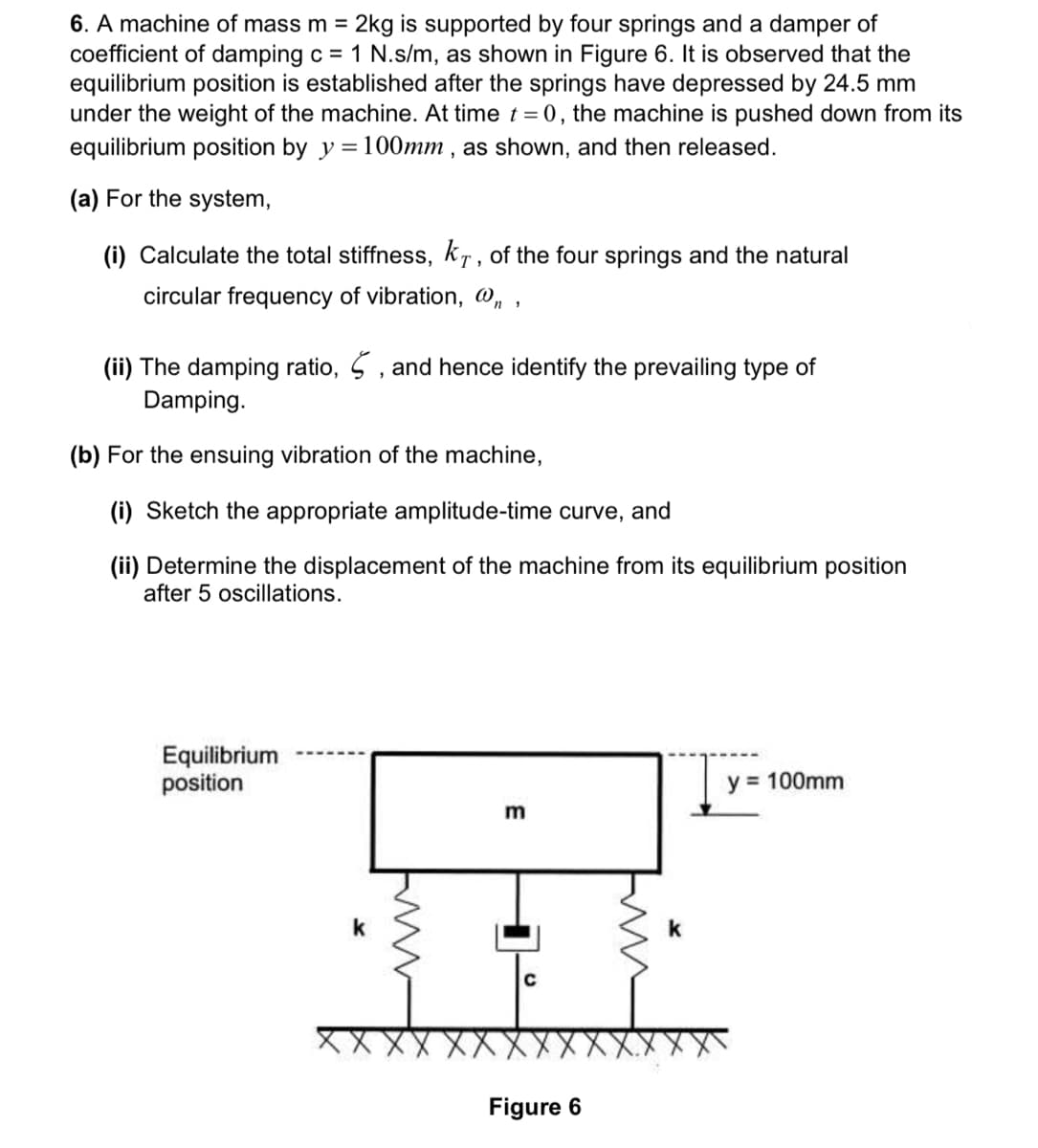6. A machine of mass m = 2kg is supported by four springs and a damper of coefficient of damping c = 1 N.s/m, as shown in Figure 6. It is observed that the equilibrium position is established after the springs have depressed by 24.5 mm under the weight of the machine. At time t = 0 , the machine is pushed down from its equilibrium position by y = 100mm , as shown, and then released. (a) For the system, (i) Calculate the total stiffness, kr, of the four springs and the natural circular frequency of vibration, @, , (ii) The damping ratio, 5 , and hence identify the prevailing type of Damping. (b) For the ensuing vibratic of the machine, (i) Sketch the appropriate amplitude-time curve, and (ii) Determine the displacement of the machine from its equilibrium position after 5 oscillations. Equilibrium position y = 100mm k Figure 6
6. A machine of mass m = 2kg is supported by four springs and a damper of coefficient of damping c = 1 N.s/m, as shown in Figure 6. It is observed that the equilibrium position is established after the springs have depressed by 24.5 mm under the weight of the machine. At time t = 0 , the machine is pushed down from its equilibrium position by y = 100mm , as shown, and then released. (a) For the system, (i) Calculate the total stiffness, kr, of the four springs and the natural circular frequency of vibration, @, , (ii) The damping ratio, 5 , and hence identify the prevailing type of Damping. (b) For the ensuing vibratic of the machine, (i) Sketch the appropriate amplitude-time curve, and (ii) Determine the displacement of the machine from its equilibrium position after 5 oscillations. Equilibrium position y = 100mm k Figure 6
Elements Of Electromagnetics
7th Edition
ISBN:9780190698614
Author:Sadiku, Matthew N. O.
Publisher:Sadiku, Matthew N. O.
ChapterMA: Math Assessment
Section: Chapter Questions
Problem 1.1MA
Related questions
Question

Transcribed Image Text:6. A machine of mass m = 2kg is supported by four springs and a damper of
coefficient of damping c = 1 N.s/m, as shown in Figure 6. It is observed that the
equilibrium position is established after the springs have depressed by 24.5 mm
under the weight of the machine. At time t = 0 , the machine is pushed down from its
equilibrium position by y = 100mm , as shown, and then released.
(a) For the system,
(i) Calculate the total stiffness, kr, of the four springs and the natural
circular frequency of vibration, @, ,
(ii) The damping ratio, 5 , and hence identify the prevailing type of
Damping.
(b) For the ensuing vibration of the machine,
(i) Sketch the appropriate amplitude-time curve, and
(ii) Determine the displacement of the machine from its equilibrium position
after 5 oscillations.
Equilibrium
position
y = 100mm
k
C
Figure 6
Expert Solution
This question has been solved!
Explore an expertly crafted, step-by-step solution for a thorough understanding of key concepts.
Step by step
Solved in 2 steps with 3 images

Knowledge Booster
Learn more about
Need a deep-dive on the concept behind this application? Look no further. Learn more about this topic, mechanical-engineering and related others by exploring similar questions and additional content below.Recommended textbooks for you

Elements Of Electromagnetics
Mechanical Engineering
ISBN:
9780190698614
Author:
Sadiku, Matthew N. O.
Publisher:
Oxford University Press

Mechanics of Materials (10th Edition)
Mechanical Engineering
ISBN:
9780134319650
Author:
Russell C. Hibbeler
Publisher:
PEARSON

Thermodynamics: An Engineering Approach
Mechanical Engineering
ISBN:
9781259822674
Author:
Yunus A. Cengel Dr., Michael A. Boles
Publisher:
McGraw-Hill Education

Elements Of Electromagnetics
Mechanical Engineering
ISBN:
9780190698614
Author:
Sadiku, Matthew N. O.
Publisher:
Oxford University Press

Mechanics of Materials (10th Edition)
Mechanical Engineering
ISBN:
9780134319650
Author:
Russell C. Hibbeler
Publisher:
PEARSON

Thermodynamics: An Engineering Approach
Mechanical Engineering
ISBN:
9781259822674
Author:
Yunus A. Cengel Dr., Michael A. Boles
Publisher:
McGraw-Hill Education

Control Systems Engineering
Mechanical Engineering
ISBN:
9781118170519
Author:
Norman S. Nise
Publisher:
WILEY

Mechanics of Materials (MindTap Course List)
Mechanical Engineering
ISBN:
9781337093347
Author:
Barry J. Goodno, James M. Gere
Publisher:
Cengage Learning

Engineering Mechanics: Statics
Mechanical Engineering
ISBN:
9781118807330
Author:
James L. Meriam, L. G. Kraige, J. N. Bolton
Publisher:
WILEY